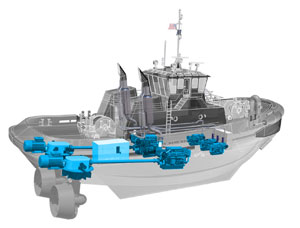Naval architects are often quick to point out that U.S. tugboat operators trail their European and Asian counterparts when it comes to adopting new technology. Lately, however, the gap appears to be narrowing.
One diesel-electric, ship-assist tugboat has already been delivered, and at least five more are planned or under construction. These tugs represent the first non-conventional propulsion system on a U.S.-built tugboat since Foss Maritime’s Carolyn Dorothy was delivered almost a decade ago.
This new generation of hybrid tugboats has one big difference from the original concept on Carolyn Dorothy: No battery power storage on board. One after another, all three operators with hybrid projects made clear they had little interest in battery-electric hybrid systems.
“We explored batteries but quickly moved on,” said Shawn Bennett, CEO of Baydelta Maritime, referring to the company’s 100-foot Delta Teresa. “Concerns about heat, weight and space were paramount,” he added, noting that the battery banks needed for such a large tug would have been “immense.”
Joe Starck, president of Great Lakes Towing Co., had similar reservations for his company’s three Great Lakes-class hybrid tugboats. He cited the lack of batteries as a key attribute of the Logan Clutch FlexaDrive system.
In the case of Delta Teresa and Harbor Docking & Towing’s Ralph and Capt. Robb, powerful diesel-electric generators provide electricity to motors installed aft of the z-drives. These motors can work independent from or in tandem with the main engines depending on the captain’s needs. Rolls-Royce/Kongsberg supplied the hybrid package for Baydelta, while Harbor Docking went with a full Caterpillar system.
The FlexaDrive system on Great Lakes Towing Co.’s three hybrid tugs operate a little differently. Twin John Deere gensets provide power to motors installed on the Twin Disc reduction gears. The motors turn the gears, which move the shaft and props.
Baydelta, based in San Francisco, and Harbor Docking in Lake Charles, La., have relatively similar operating profiles. Both often travel long distances to or from jobs, and they envision idling their main engines and using only the electric motors when running light. Both companies said their tugs achieved at least 9 knots in hybrid mode during sea trials.
The three firms preparing to roll out these new tugs have high hopes for the technology. They expect reduced fuel consumption and substantially less wear on the main engines. Lower emissions are another benefit separate from each company’s bottom line.
“The two big expenses are people and fuel,” said John Buchanan, president of Harbor Docking & Towing. “And less fuel means less maintenance, so we can run a more efficient operation.”
 |
|
This diagram shows the arrangement and hybrid components aboard Delta Teresa. |
|
Jensen Maritime Consultants |
It’s safe to assume the tugboat industry will pay close attention to how these vessels perform. Buchanan has fielded inquiries from other operators interested in the technology. Several companies sent representatives to the Washburn & Doughty shipyard to see the hybrid system firsthand. Harbor Docking customers also are following the project closely.
There are some other, less obvious benefits to hybrid propulsion. One is the ability to achieve desired bollard pull ratings with smaller engines. Delta Teresa’s two Cat 3516 mains deliver 5,300 combined horsepower. The two Marelli Motori electric motors add more than 1,200 hp. Bollard pull exceeds 90 short tons ahead when the mains and hybrid system are running at full power.
Ralph achieves 84 metric tons ahead using Caterpillar 3512 engines combined with ABB electric thruster motors.
The electric motors also can run at substantially lower rpms than the main engines. Captains running Delta Teresa, for instance, can turn the props as slowly as 1 rpm should the need arise. That option allows for better control for “finesse”-type work or when working in areas sensitive to prop wash.
And then there is the potential for significant savings from reduced maintenance and less frequent overhauls on the main engines. “In the long term, maintaining a 300-kW diesel is certainly a lot less expensive than a 3,300-hp main engine,” said Bryan Nichols, director of business development for Jensen Maritime Consultants, which designed Delta Teresa. “There are more benefits, and they are just starting to be realized by the industry. I think we will see that more as these vessels come online.”
Mike Fitzpatrick, president of the Vancouver, B.C., naval architecture firm Robert Allan Ltd., is among those expecting wider acceptance of hybrid technology in the U.S. and elsewhere. But he cautions that these systems are not “one size fits all.”
Each hybrid system needs to be tailored, Fitzpatrick explained. “It is not easy to make an economic case for a hybrid tug in terms of fuel consumption alone,” he said. “But one of the biggest factors for a hybrid system paying for itself over the years is the reduced maintenance cost from reduced running hours on the main engine.”
For now, cost is one persistent hurdle. Depending on the size of the tugboat and the system involved, hybrid tugs can cost $1 million to $2 million more than a conventionally powered ASD vessel. Battery systems would raise the price of a hybrid tug even more.
But more hybrid projects are likely in the future if these new U.S. tugs perform anywhere near expectations. “Hybrid tugs,” Fitzpatrick said, “are definitely becoming more and more a part of the normal way of building a tug nowadays.”

